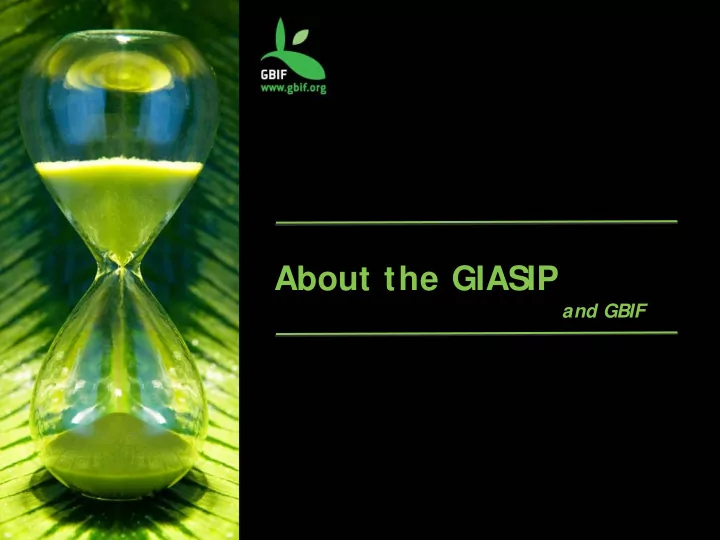

About the GIASIP and GBIF
About GBIF
The Global Biodiversity Information Facility Vision “ A world in which biodiversity information is freely and universally available for science, society, and a sustainable future.” Mission To be t he foremost global resource for biodiversit y informat ion, and engender smart solut ions for environment al and human well- being.
Growth in GBIF Participation 120 Participants as of end-2011 yet to sign new MOU Other Associate Participants 100 Associate Countries Voting Countries 39 47 80 46 43 39 34 34 31 60 29 24 30 24 23 22 18 40 20 16 20 20 11 17 14 8 10 7 20 33 32 32 29 29 26 26 26 25 24 22 21 0 2001 2002 2003 2004 2005 2006 2007 2008 2009 2010 2011 2012 Last updated: 2012-04-16
GBIF Participation Last updated: 2012-04-16
The niche of GBIF Content area Existing responsibilities of responsibilities of GBIF other agencies GBIF would enable synergies among existing investments that is not possible at present
The IT challenges… Registry Services Other domains Registering Discovering Publishers Users Harvesting & Indexing Discovering Publishing Collections
The GBIF informatics infrastructure Discovering Integrating Publishing
The GBIF informatics infrastructure A global infrastructure for the sharing of biodiversity data
About the data Primary Biodiversity Data Primary Biodiversity Data is defined as: Digital text or multimedia data record detailing facts about the instance of occurrence of an organism, i.e. on the what , where , when , how and by whom of the occurrence and the recording. Observational data pecimen data S
About the data An example of primary biodiversity data
About the data An example of primary biodiversity data
Growth in data publishers 410 400 390 380 370 360 350 340 330 320 310 300 290 280 270 260 250 240 230 220 210 Last updated: 2012-05-02
Growth in data records 410 400 390 380 Million of primary biodiversity records 370 360 350 340 330 320 310 300 290 280 270 260 250 240 230 220 210 Last updated: 2012-05-02
Unifying species data Invasive Alien Invasive Species Alien Species Ecological Genomic Darwin Core Integrated access for records of the occurrence of any species: • What? Phenotypic • When? • Where? • What evidence? • Data owner? • Link to full record Invasive Alien Species
The coverage in 2012 Occurrences
About our contribution
How we see our role in GIASIP GIASIP Partner A Partner B GIASIP ’Portal’ GBIF User User
How we see the benefits from GIASIP To provide additional value to To mobilize addit ional what GBIF does alone… specimen/ observat ions records relevant t o IAS agenda. To enrich exist ing informat ion syst ems (CABI, GIS D, GIS IN, FishBase, DAIS IE, NOBANIS … ) To provide IAS specific user int erface (e.g. in support of To cont ribut e t o t he development of assessment s et c.) an IAS IT infrast ruct ure (e.g. web services, dat a st andards, t ools et c.) To mobilize t he GBIF communit y (dat a publishers, scient ist s et c.) To demonst rat e t he relevance of GBIF in cont ribut ing t o t he Aichi t arget s (not only IAS ) To enable GIAS IP t o become a t hemat ic discovery syst em.
How we see the benefits from GIASIP What GIASIP shouldn’t do! Duplicat e t he funct ions of t he cont ribut ing informat ion syst ems. Become (yet anot her) port al providing nice user int erface but lit t le added value. Be coordinat ed by a single organizat ion. To develop it s own IT infrast ruct ure incompat ible wit h exist ing global init iat ives (e.g. GBIF). Become (yet anot her) dat abase duplicat ing all records/ informat ion Developed out side t he CBD from ot her informat ion syst ems. Clearing-House Mechanism Ignore t he primary end-user requirement s (i.e. CBD part ies!)
How we see the GIASIP Some ideas… S hould be conceived as a P AR TNERS HIP and not a new organizat ion or informat ion syst em, Needs t o cont ribut e t o t he CBD Aichi Target s t hrough t he CHM, Clear goals and obj ect ives, Measurable t arget s for t he short , medium and long-t erm, Clear governance (e.g. st eering commit t ee et c.), Formal agreement s in t he form of a MoU/ MoC, Clear roles and responsibilit ies bet ween part ners and t he CBD S ecret ariat , S t rat egic fund-raising around a business plan for t he next 5-10 years, Key product s art iculat ed, priorit y species ident ified, st rat egic regions agreed, et c. Develop a new model for ot her Aichi t arget s (e.g. t hreat ened species, prot ect ed areas et c.). Engage ot her part ners! EOL, COL, CBOL, F AO, et c.
Carcinus maenas Carcinus maenas is a common littoral crab, and an important invasive species, listed among the 100 "world's worst alien invasive species".[2] It is native to the north-east Atlantic Ocean and Baltic S ea, but has colonised similar habitats in Australia, S outh Africa, S outh America and both Atlantic and Pacific coasts of North America. It grows to a carapace width of 90 millimetres (3.5 in), and feeds on a variety of molluscs, worms and small crustaceans, potentially impacting a number of fisheries. Its successful dispersion has occurred via a variety of mechanisms, such as on ships' hulls, packing materials, bivalves moved for aquaculture, and rafting. Rough map of the distribution of Carcinus maenas , blue areas are the native range, red areas are the introduced or invasive range, black dots represent single sightings that did not lead to invasion, and green areas are the potential range of the species.
Carcinus maenas Species distribution (Maxent)
Carcinus maenas
100 IAS
Thank you!
Recommend
More recommend